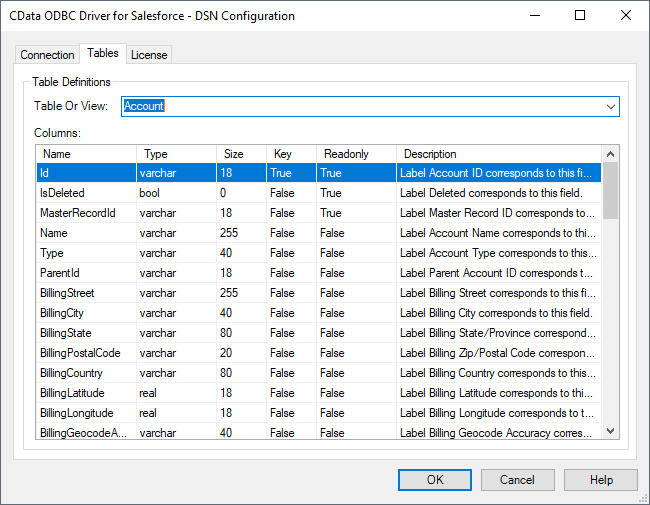Discover how a bimodal integration strategy can address the major data management challenges facing your organization today.
Get the Report →How to connect PolyBase to JSON
Use CData drivers and PolyBase to create an external data source in SQL Server 2019 with access to live JSON services.
PolyBase for SQL Server allows you to query external data by using the same Transact-SQL syntax used to query a database table. When paired with the CData ODBC Driver for JSON, you get access to your JSON services directly alongside your SQL Server data. This article describes creating an external data source and external tables to grant access to live JSON services using T-SQL queries.
NOTE: PolyBase is only available on SQL Server 19 and above, and only for Standard SQL Server.
The CData ODBC drivers offer unmatched performance for interacting with live JSON services using PolyBase due to optimized data processing built into the driver. When you issue complex SQL queries from SQL Server to JSON, the driver pushes down supported SQL operations, like filters and aggregations, directly to JSON and utilizes the embedded SQL engine to process unsupported operations (often SQL functions and JOIN operations) client-side. And with PolyBase, you can also join SQL Server data with JSON services, using a single query to pull data from distributed sources.
Connect to JSON
If you have not already, first specify connection properties in an ODBC DSN (data source name). This is the last step of the driver installation. You can use the Microsoft ODBC Data Source Administrator to create and configure ODBC DSNs. To create an external data source in SQL Server using PolyBase, configure a System DSN (CData JSON Sys is created automatically).
See the Getting Started chapter in the data provider documentation to authenticate to your data source: The data provider models JSON APIs as bidirectional database tables and JSON files as read-only views (local files, files stored on popular cloud services, and FTP servers). The major authentication schemes are supported, including HTTP Basic, Digest, NTLM, OAuth, and FTP. See the Getting Started chapter in the data provider documentation for authentication guides.
After setting the URI and providing any authentication values, set DataModel to more closely match the data representation to the structure of your data.
The DataModel property is the controlling property over how your data is represented into tables and toggles the following basic configurations.
- Document (default): Model a top-level, document view of your JSON data. The data provider returns nested elements as aggregates of data.
- FlattenedDocuments: Implicitly join nested documents and their parents into a single table.
- Relational: Return individual, related tables from hierarchical data. The tables contain a primary key and a foreign key that links to the parent document.
See the Modeling JSON Data chapter for more information on configuring the relational representation. You will also find the sample data used in the following examples. The data includes entries for people, the cars they own, and various maintenance services performed on those cars.
Click "Test Connection" to ensure that the DSN is connected to JSON properly. Navigate to the Tables tab to review the table definitions for JSON.
Create an External Data Source for JSON Services
After configuring the connection, you need to create a master encryption key and a credential database for the external data source.
Creating a Master Encryption Key
Execute the following SQL command to create a new master key, 'ENCRYPTION,' to encrypt the credentials for the external data source.
CREATE MASTER KEY ENCRYPTION BY PASSWORD = 'password';
Creating a Credential Database
Execute the following SQL command to create credentials for the external data source connected to JSON services.
NOTE: Since JSON does not require a User or Password to authenticate, you may use whatever values you wish for IDENTITY and SECRET.
CREATE DATABASE SCOPED CREDENTIAL json_creds WITH IDENTITY = 'username', SECRET = 'password';
Create an External Data Source for JSON
Execute a CREATE EXTERNAL DATA SOURCE SQL command to create an external data source for JSON with PolyBase:
- Set the LOCATION parameter , using the DSN and credentials configured earlier.
For JSON, set SERVERNAME to the URL or address for your server (e.g. 'localhost' or '127.0.0.1' for local servers; the remote URL for remote servers). Leave PORT empty. PUSHDOWN is set to ON by default, meaning the ODBC Driver can leverage server-side processing for complex queries.
CREATE EXTERNAL DATA SOURCE cdata_json_source WITH ( LOCATION = 'odbc://SERVER_URL', CONNECTION_OPTIONS = 'DSN=CData JSON Sys', -- PUSHDOWN = ON | OFF, CREDENTIAL = json_creds );
Create External Tables for JSON
After creating the external data source, use CREATE EXTERNAL TABLE statements to link to JSON services from your SQL Server instance. The table column definitions must match those exposed by the CData ODBC Driver for JSON. You can refer to the Tables tab of the DSN Configuration Wizard to see the table definition.

Sample CREATE TABLE Statement
The statement to create an external table based on a JSON people would look similar to the following:
CREATE EXTERNAL TABLE people( [ personal.name.first ] [nvarchar](255) NULL, [ personal.name.last ] [nvarchar](255) NULL, ... ) WITH ( LOCATION='people', DATA_SOURCE=cdata_json_source );
Having created external tables for JSON in your SQL Server instance, you are now able to query local and remote data simultaneously. Thanks to built-in query processing in the CData ODBC Driver, you know that as much query processing as possible is being pushed to JSON, freeing up local resources and computing power. Download a free, 30-day trial of the ODBC Driver for JSON and start working with live JSON services alongside your SQL Server data today.






